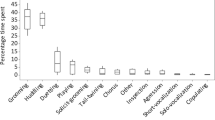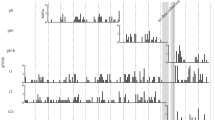Abstract
We introduced two to four unfamiliar animals into three established groups (N = 6–9 per group) of tufted capuchins (Cebus apella).We present findings on the behavioral consequences of introductions as a function of age, sex, and residency status and long-term consequences for health and reproduction. No morbidity from aggression occurred at the time of introductions or during several months following, and reproduction was not compromised. Activity budgets and patterns of social spacing and interaction were little changed following the introductions except for increases in vigilance behavior, especially by newly introduced adult females. Adult females exhibited the strongest and longest-lasting response to changes in group composition. The results indicate that in this species (1) introductions of adult females can be carried out with acceptable risk to the newcomers provided that careful monitoring occurs, so that the onset of severe aggression instigated by resident females toward new females can be avoided, (2) juveniles can be introduced with minimal risk, and (3) adult males can be introduced into groups lacking resident adult males with minimal risk. Capuchins differ in important ways from the better-studied Old World monkeys in their response to introductions of strangers. The differences are instructive with regard to processes supporting species-typical social structure, which is less overtly hierarchical in capuchins than in macaques.
Similar content being viewed by others
References
Bernstein, I. (1971). The influence of introductory techniques on the formation of captive mangabey groups.Primates 12: 33–44.
Bernstein, I., and Gordon, T. (1974). The function of aggression in primate societies.Am. Sci. 62: 304–311.
Bowden, R. (1988). Primate research and “psychological well-being.”Science 240: 12.
Boinski, S. (1988). Sex differences in the foraging behavior of squirrel monkeys in a seasonal habitat.Behav. EcoL Sociobiol. 23: 177–186.
de Waal, F. (1986). The integration of dominance and social bonding in primates.Q. Rev. Biol. 61: 459–479.
de Waal, F. (1989).Peacemaking Among Primates, Harvard University Press, Cambridge, MA.
Hrdy, S. B. (1979). Infanticide among animals: A review, classification, and examination of the implications for the reproductive strategies of females.Ethol. SociobioL 1: 13–40.
Janson, C. (1984). Female choice and mating systems of the brown capuchin monkeyCebus apella (Primates: Cebidae).Z. TierpsychoL 65: 177–200.
Novak, M., and Suomi, S. (1988). Psychological well-being of primates in captivity.Am. Psychol. 43: 765–773.
Phillips, K., Bernstein, I., Dettmer, E., Devermann, H., and Powers, M. (1993). Sexual behavior in brown capuchin monkeys(Cebus apella) Am. J. Primatol. (in press).
Rhine, R., and Cox, R. (1989). How not to enlarge a stable group of stump-tailed macaques(Macaca arctoides). In Segal, E. (ed.),Housing, Care and Psychological Weil-Being of Captive and Laboratory Primates, Noyes, Parkridge, NJ, pp. 255–269.
Robinson, J. G. (1981). Spatial structure in foraging groups of wedgecapped capuchins.Anim. Behav. 29: 1036–1056.
Robinson, J., and Janson, C. (1986). Capuchins, squirrel monkeys, and atelines: Socioecological convergence with Old World primates. In Smuts, B., Cheney, D., Seyfarth, R., Wrangham, R., and Struhsaker, T. (eds.),Primate Societies, University Press, Chicago.
Valderrama, X., Srikosamatara, S., and Robinson, J. (1990). Infanticide in wedge-capped monkeys(Cebus olivaceus).Folia PrimatoL 54: 171–176.
Visalberghi, E., and Welker, C. (1986). Sexual behavior inCebus apella.Antrop. Contemp. 9: 164–165.
Welker, C. (1979). Zum sozialverhalten des KapuzineraffenCebus apella cay Illiger, 1815, in Gefangenschaft. I. Gruppenbildungprozesses.Philippia 4: 154–168.
Welker, C. (1992). Long-term studies on the social behavior of the capuchin monkey, Cebus apella. In Seth, P. K., and Seth, S. (eds.),Perspectives in Primate Biology, Vol. 4, Today and Tomorrow's, New Delhi, pp. 9–16.
Welker, C, Brinkmann, C, and Schafer, C. (1981). Zum sozialverhalten des KapuzineraffenCebus Apella cay Illiger, 1815, in Gefangenschaft. II. Gruppenbewustein.Philippia 4: 331–342.
Author information
Authors and Affiliations
Rights and permissions
About this article
Cite this article
Fragaszy, D., Baer, J. & Adams-Curtis, L. Introduction and integration of strangers into captive groups of tufted capuchins (Cebus apella). International Journal of Primatology 15, 399–420 (1994). https://doi.org/10.1007/BF02696101
Received:
Revised:
Accepted:
Issue Date:
DOI: https://doi.org/10.1007/BF02696101




